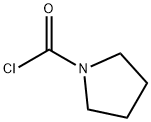Diethylcarbamyl chloride
Synonym(s):Chloroformic acid diethylamide
- CAS NO.:88-10-8
- Empirical Formula: C5H10ClNO
- Molecular Weight: 135.59
- MDL number: MFCD00000636
- EINECS: 201-798-5
- SAFETY DATA SHEET (SDS)
- Update Date: 2025-09-25 17:15:13

What is Diethylcarbamyl chloride?
Description
Diethylcarbamoyl chloride is a colorless liquid.Molecular weight=135.61; Boiling point=186-190℃;Melting point=244; Flash point=163-172℃. HazardIdentification (based on NFPA-704 M Rating System):Health 2, Flammability 1, Reactivity 2. Soluble in water(reactive).
Chemical properties
clear yellow to brownish liquid
The Uses of Diethylcarbamyl chloride
It is used in the production of pharma ingredients. It is a reagent in the synthesis of S-Methyl-N,N-diethylthiocarbamate Sulfoxide, which is an oxygenated metabolite of Disulfiram (Antabuse) that is capable of in vitro inactivation of liver mitochondrial aldehyde dehydrogenase.
Safety Profile
Suspected carcinogen with experimental carcinogenic data. Moderately toxic by intraperitoneal route. Mutation data reported. Reacts with water or steam to produce toxic and corrosive fumes. When heated to decomposition it emits highly toxic fumes of Cl and NOx. See also CARBATMATES and CHLORIDES.
Toxicology
The median lethal dose (LD50) upon oral administration to rats is about 200 mg/kg. The compound is irritating to skin and eyes. The inhalation of an atmosphere saturated with its vapors at 20℃ is lethal to rats after 3 h. Diethylcarbamoyl chloride has proved to be mutagenic on E. coli strains in mutagenicity tests. It is weakly mutagenic in high doses in the Ames test. In view of these results and on account of the structural similarity to dimethylcarbamoyl chloride, a carcinogenic potential cannot be ruled out. The MAK commission has listed this substance in group III B.
Potential Exposure
Diethylcarbamazine citrate, a carbamate anthelmintic (working agent), used in the synthesis ofpharmaceuticals.
First aid
If this chemical gets into the eyes, remove anycontact lenses at once and irrigate immediately for at least15 min, occasionally lifting upper and lower lids. Seek medical attention immediately. If this chemical contacts theskin, remove contaminated clothing and wash immediatelywith soap and water. Seek medical attention immediately. Ifthis chemical has been inhaled, remove from exposure,begin rescue breathing (using universal precautions, including resuscitation mask) if breathing has stopped and CPR ifheart action has stopped. Transfer promptly to a medicalfacility. When this chemical has been swallowed, get medical attention. If victim is conscious, administer water ormilk. Do not induce vomiting.
Storage
Color Code—Blue: Health Hazard/Poison: Storein a secure poison location. Prior to working with thischemical you should be trained on its proper handling andstorage. Store in tightly closed containers in a cool, wellventilated area away from oxidizers and reducing agents.Where possible, automatically pump liquid from drums orother storage containers to process containers. A regulated,marked area should be established where this chemical ishandled, used, or stored in compliance with OSHAStandard 1910.1045.
Shipping
Toxic liquids, water-reactive, n.o.s. require a labelof “POISONOUS/TOXIC MATERIALS, DANGEROUSWHEN WET.” They fall in Hazard Class 6.1.
Incompatibilities
Will react with water or steam to producetoxic and corrosive fumes.
Properties of Diethylcarbamyl chloride
| Melting point: | −32 °C(lit.) |
| Boiling point: | 117-123 °C133 mm Hg(lit.) |
| Density | 1.07 g/mL at 25 °C(lit.) |
| refractive index | n |
| Flash point: | 167 °F |
| storage temp. | Inert atmosphere,2-8°C |
| solubility | Chloroform (Soluble), Methanol (Slightly) |
| pka | -1.85±0.70(Predicted) |
| form | Liquid |
| Specific Gravity | 1.070 |
| color | Clear |
| Water Solubility | HYDROLYSIS |
| Sensitive | Moisture Sensitive |
| BRN | 506687 |
| Stability: | Moisture Sensitive |
| CAS DataBase Reference | 88-10-8(CAS DataBase Reference) |
| NIST Chemistry Reference | Carbamic chloride, diethyl-(88-10-8) |
| EPA Substance Registry System | Diethylcarbamoyl chloride (88-10-8) |
Safety information for Diethylcarbamyl chloride
| Signal word | Warning |
| Pictogram(s) |
 Exclamation Mark Irritant GHS07  Health Hazard GHS08 |
| GHS Hazard Statements |
H315:Skin corrosion/irritation H319:Serious eye damage/eye irritation H335:Specific target organ toxicity, single exposure;Respiratory tract irritation H351:Carcinogenicity |
| Precautionary Statement Codes |
P202:Do not handle until all safety precautions have been read and understood. P301+P312:IF SWALLOWED: call a POISON CENTER or doctor/physician IF you feel unwell. P302+P352:IF ON SKIN: wash with plenty of soap and water. P305+P351+P338:IF IN EYES: Rinse cautiously with water for several minutes. Remove contact lenses, if present and easy to do. Continuerinsing. P308+P313:IF exposed or concerned: Get medical advice/attention. |
Computed Descriptors for Diethylcarbamyl chloride
| InChIKey | OFCCYDUUBNUJIB-UHFFFAOYSA-N |
Diethylcarbamyl chloride manufacturer
JSK Chemicals
New Products
4,4-Difluoropiperidine hydrochloride tert-butyl 9-methoxy-3-azaspiro[5.5]undecane-3-carboxylate Indole Methyl Resin N-Isopropylurea N,N-Dicyclohexylcarbodiimide(DCC) MELDRUMS ACID 5-METHYLISOXAZOLE-4-CARBOXYLIC ACID Magnessium Bis glycinate Zinc ascorbate 1-bromo-2-butyne 2-acetamidophenol 9(10H)-anthracenone Erythrosin B, 4-Piperidinopiperidine 2-((4-morpholinophenylamino) (methylthio) methylene) malononitrile 2,4-dihydroxybenzaldehyde 3-(4-morpholinophenylamino)-5-amino-1H-pyrazole-4-carbonitrile Methyl 2-methylquinoline-6-carboxylate 2,6-dichloro-4-nitropyridine 4-Bromo-2-chlorobenzonitrile 2-(benzylamino)acetic acid hydrochloride 4-(tert-Butoxycarbonylamino)but- 2-ynoic acid 3,4-dihydro-2H-benzo[b][1,4]dioxepine 1-Phenyl-1-cycloprppanecarboxylicacidRelated products of tetrahydrofuran








You may like
-
 88-10-8 98%View Details
88-10-8 98%View Details
88-10-8 -
 Diethylcarbamoyl chloride, 97% 88-10-8 99%View Details
Diethylcarbamoyl chloride, 97% 88-10-8 99%View Details
88-10-8 -
 Diethylcarbamoyl Chloride CAS 88-10-8View Details
Diethylcarbamoyl Chloride CAS 88-10-8View Details
88-10-8 -
 Diethylcarbamyl chloride CAS 88-10-8View Details
Diethylcarbamyl chloride CAS 88-10-8View Details
88-10-8 -
 DIETHYL CARBAMOYL CHLORIDE CAS: 88-10-8View Details
DIETHYL CARBAMOYL CHLORIDE CAS: 88-10-8View Details
88-10-8 -
 20677-73-0 (2,2-diethoxyethyl)methylamine 98%View Details
20677-73-0 (2,2-diethoxyethyl)methylamine 98%View Details
20677-73-0 -
 3-(4-(hydroxyamino)-1-oxoisoindolin-2-yl)piperidine-2,6-dione 98%View Details
3-(4-(hydroxyamino)-1-oxoisoindolin-2-yl)piperidine-2,6-dione 98%View Details -
 57381-49-4 2-bromo-4-chlorobenzonitrile 98%View Details
57381-49-4 2-bromo-4-chlorobenzonitrile 98%View Details
57381-49-4
